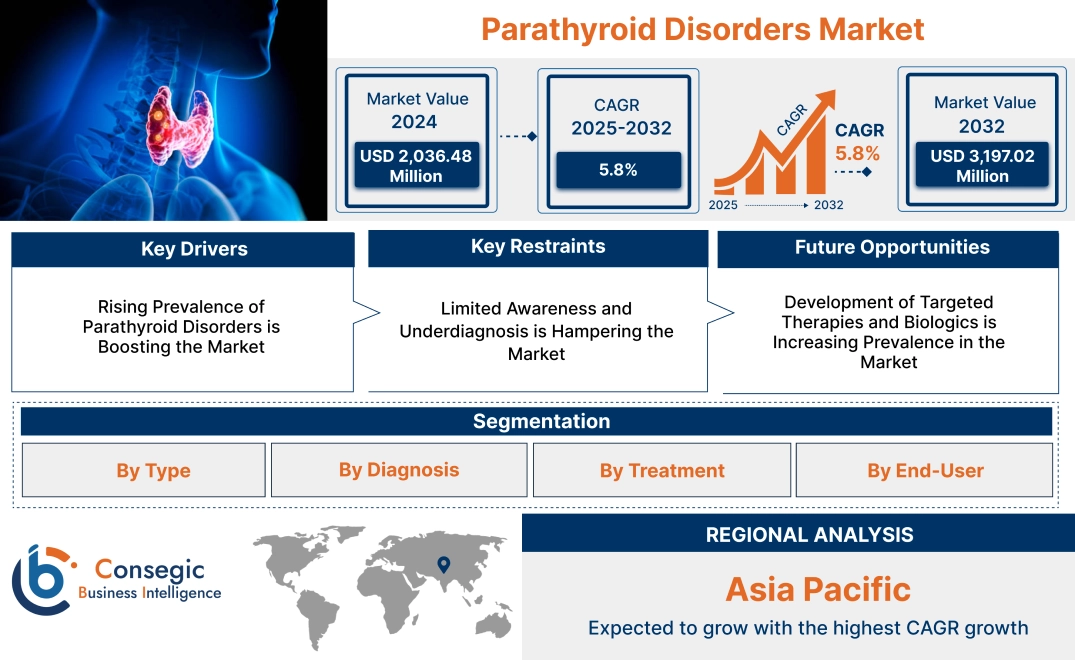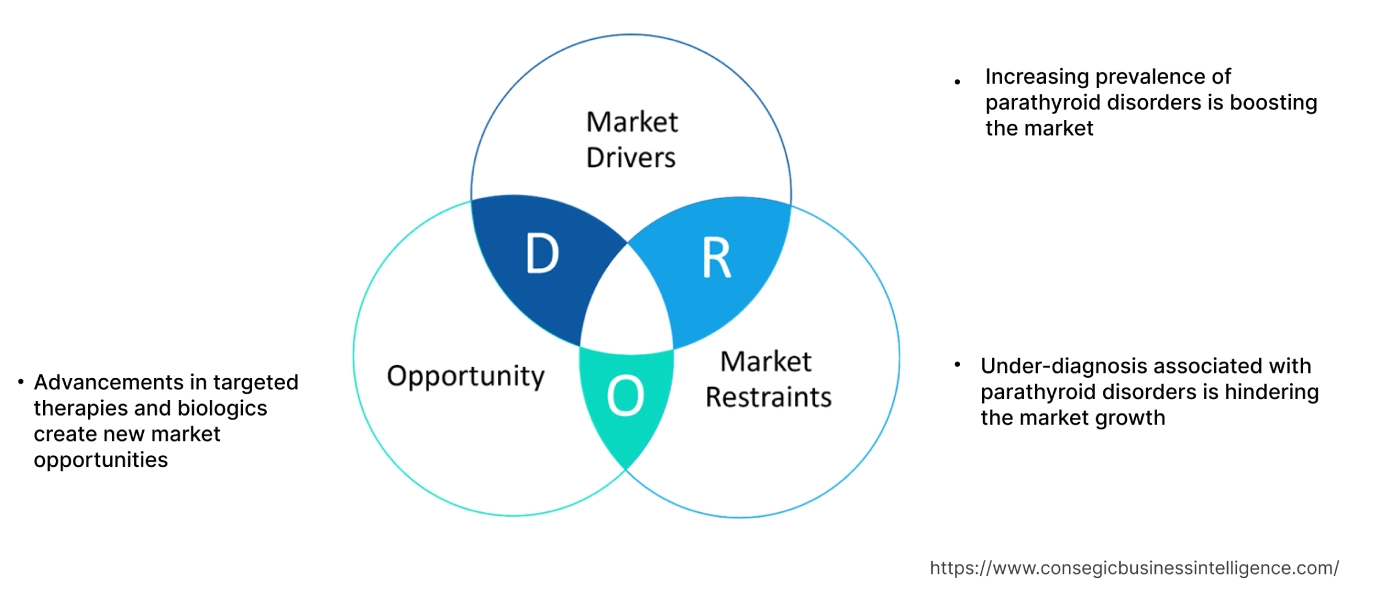Parathyroid Disorders Market Size:
Parathyroid Disorders Market size is estimated to reach over USD 3,197.02 Million by 2032 from a value of USD 2,036.48 Million in 2024 and is projected to grow by USD 2,118.31 Million in 2025, growing at a CAGR of 5.8% from 2025 to 2032.
How AI is Impacting the Parathyroid Disorders Market?
AI is significantly impacting the parathyroid disorders market by revolutionizing diagnosis, treatment planning, and surgical precision. AI-powered image analysis, particularly with technologies like near-infrared autofluorescence, assists surgeons in real-time to accurately identify and preserve parathyroid glands during complex surgeries, reducing complications like hypoparathyroidism. Furthermore, AI helps analyze vast patient data to improve diagnostic accuracy for conditions like hyperparathyroidism and personalized treatment regimens. Its role extends to predicting disease progression and potentially accelerating drug discovery for new therapeutic targets, ultimately leading to more effective and safer patient care in this specialized endocrine field.
Parathyroid Disorders Market Dynamics - (DRO) :
Key Drivers:
Increasing prevalence of parathyroid disorders is boosting the market
Parathyroid disorders, like hyperparathyroidism and hypoparathyroidism, are caused by problems with the parathyroid glands, which regulate calcium and phosphate levels in the body. These glands can become overactive or underactive due to various factors, including tumors, enlarged glands, kidney disease, and genetic conditions. Chronic kidney disease leads to a buildup of phosphate in the blood, which can trigger the parathyroid glands to overwork. Insufficient vitamin D can impair calcium absorption, leading to lower calcium levels and increased PTH secretion. Not enough calcium in the diet or poor calcium absorption can also trigger secondary hyperparathyroidism.
- For instance, Yale Medicine offers treatment and solutions for parathyroid disorder. It offers a team-based approach, with physicians, physical therapists, nurse practitioners, and nutritionists providing personalized care.
Thus, the aforementioned factors are boosting the parathyroid disorders market growth.
Key Restraints:
Under-diagnosis associated with parathyroid disorders is hindering the market growth
Under-diagnosis of parathyroid disorders, particularly primary hyperparathyroidism (PHPT), can have significant consequences for patients, including increased risk of complications, such as kidney stones, osteoporosis, and cardiovascular disease. The under-diagnosis of PHPT is a serious issue, with only a small percentage of eligible patients receiving appropriate diagnostic workups and surgical treatment. Thus, the aforementioned factors are limiting the parathyroid disorders market demand.
Future Opportunities :
Advancements in targeted therapies and biologics create new market opportunities
Targeted therapies and biologics offer new approaches to treating parathyroid disorders, particularly in advanced cases like parathyroid carcinoma. These therapies focus on specific molecular targets within the cancer cells, allowing more precise and effective treatment. In addition to targeted therapies, biologics, like recombinant parathyroid hormone (PTH), are used for managing hypoparathyroidism.
Additionally, patient-derived parathyroid organoids are used as in vitro models to study parathyroid physiology and test potential therapies. These organoids exhibit self-renewal, mimic parathyroid tissue, and respond to calcium and PTH-lowering drugs, demonstrating their functionality. They are used to identify new targets and imaging tracers for parathyroid diseases. Thus, the advancements in targeted therapies and biologics are expected to boost the parathyroid disorders market opportunities.
Parathyroid Disorders Market Segmental Analysis :
By Type:
Based on type, the market is segmented into hyperparathyroidism and hypoparathyroidism.
Trends in the Type:
- Rising prevalence of hyperparathyroidism due to increased calcium levels in the blood is boosting the parathyroid disorders market size.
- Increasing prevalence of hypoparathyroidism due to damage of parathyroid glands during surgery.
The hyperparathyroidism segment accounted for the largest revenue share in 2024.
- Hyperparathyroidism is a condition where one or more of the parathyroid glands produce too much parathyroid hormone (PTH), leading to elevated calcium levels in the blood.
- This occurs in primary hyperparathyroidism due to a problem with the parathyroid glands themselves, or in secondary hyperparathyroidism due to another underlying condition affecting calcium and phosphate balance.
- Both primary and secondary hyperparathyroidism can lead to elevated calcium levels and various health problems.
- Treatment options include surgery, medications, and addressing underlying causes.
- Thus, the aforementioned factors are driving the parathyroid disorders market growth.
The hypoparathyroidism segment is anticipated to register the fastest CAGR during the forecast period.
- Hypoparathyroidism, a condition where the parathyroid glands produce insufficient parathyroid hormone (PTH), is primarily caused by damage to the parathyroid glands during surgery, particularly thyroid or neck surgery.
- Other causes include autoimmune disorders, genetic conditions, and low blood magnesium levels.
- The most common cause is accidental damage or removal of the parathyroid glands during surgery, particularly thyroidectomy or neck surgery.
- In some cases, the body's immune system mistakenly attacks the parathyroid glands, leading to decreased PTH production.
- Thus, the analysis depicts that the aforementioned factors are expected to drive the parathyroid disorders market demand.
By Diagnosis:
Based on diagnosis, the market is segmented into blood tests, imaging tests, and bone density tests.
Trends in the Diagnosis:
- Increasing trend in the adoption of blood tests for diagnosis due to their accuracy and convenience is boosting the parathyroid disorders market size.
- Rising adoption of bone density tests to diagnose calcium levels in bones is driving the market.
The blood tests segment accounted for the largest revenue in parathyroid disorders market share in 2024.
- Parathyroid disorders, particularly hyperparathyroidism and hypoparathyroidism, are often diagnosed through blood tests, specifically measuring parathyroid hormone (PTH) and calcium levels.
- These tests help determine if the parathyroid glands are producing too much or too little PTH, which can affect calcium levels in the blood.
- Parathyroid hormone (PTH) blood test measures the amount of PTH in the blood. PTH is a hormone produced by the parathyroid glands that regulates calcium levels.
- Therefore, the analysis shows that the above factors are driving the parathyroid disorders market expansion.
The imaging tests segment is anticipated to register the fastest CAGR during the forecast period.
- Imaging tests, including ultrasound, parathyroid scintigraphy (Sestamibi scan), CT scans, and MRI are used to diagnose and localize parathyroid disorders, particularly in cases of hyperparathyroidism.
- These tests help identify abnormal parathyroid glands, such as adenomas or hyperplasia, that may be causing elevated parathyroid hormone (PTH) levels and associated calcium imbalances.
- Ultrasound is a non-invasive imaging technique that uses sound waves to visualize the parathyroid glands and surrounding tissues. It helps to identify enlarged glands or other abnormalities, often used in conjunction with other imaging tests.
- Parathyroid scintigraphy is a nuclear medicine procedure that uses a radioactive tracer (sestamibi) to visualize the parathyroid glands. This scan is particularly useful for locating abnormal parathyroid tissue that may be responsible for hyperparathyroidism.
- Thus, the analysis depicts that the aforementioned factors are expected to drive the parathyroid disorders market expansion.
By Treatment:
Based on treatment, the market is segmented into medications, surgery, hormone replacement therapy, and dietary management.
Trends in the Treatment:
- Rising adoption of dietary management as a treatment of parathyroid conditions due to its effectiveness and convenience is boosting the market demand.
- Increasing trend in adoption of hormone replacement therapy to manage bone health.
The medications segment accounted for the largest revenue in parathyroid disorders market share in 2024.
- Medications play a crucial role in managing disorders, particularly in situations where surgery is not feasible or has not been successful.
- For hyperparathyroidism, calcimimetics like cinacalcet can help lower calcium levels by reducing parathyroid hormone (PTH) production.
- In hypoparathyroidism, parathyroid hormone injections and calcium supplements are used to restore calcium balance.
- Cinacalcet is a calcimimetic that mimics the effect of calcium, tricking the parathyroid glands into producing less PTH. It's used to treat primary hyperparathyroidism.
- Medications like alendronate can help prevent calcium loss from bones and improve bone density, which can be beneficial for those with bone loss due to hyperparathyroidism.
- Thus, the analysis shows that the aforementioned factors are driving the parathyroid disorders market opportunities.
The hormone replacement therapy segment is anticipated to register the fastest CAGR during the forecast period.
- Parathyroid disorders, such as hypoparathyroidism (low PTH) and hyperparathyroidism (high PTH), can be managed using various treatments, including hormone replacement therapy.
- Hormone replacement therapy, specifically parathyroid hormone replacement, is used in hypoparathyroidism to address low blood calcium levels.
- In hyperparathyroidism, hormone therapy may involve the use of bisphosphonates or selective estrogen receptor modulators (SERMs) to manage bone health.
- Thus, the parathyroid disorders market analysis shows that the aforementioned factors are expected to drive the parathyroid disorders market trends.
By End-User:
Based on end-user, the market is segmented into hospitals, specialty clinics, ambulatory surgical centers, and homecare settings.
Trends in the End-User:
- Rising demand in hospitals for treatment due to advanced imaging and surgical expertise is boosting the market demand.
- Increasing trend in the adoption of specialty clinics for personalized care and expertise is driving the market growth.
The hospitals segment accounted for the largest revenue share of 38.90% in the parathyroid disorders market in 2024.
- Hospitals offer minimally invasive parathyroidectomy, a safe and effective treatment option for primary hyperparathyroidism.
- They provide comprehensive care for parathyroid diseases, including advanced imaging and surgical expertise.
- Hospitals also offer various treatment options for parathyroid adenomas, including surgery and medication.
- Thus, the parathyroid disorders market analysis shows that the aforementioned factors are driving the market growth.
The specialty clinics segment is anticipated to register the fastest CAGR during the forecast period.
- Specialty clinics offer consultations and care, as ENT specialists can also be involved in neck surgeries related to parathyroid glands.
- Specialty clinics focus on thyroid and hormone-related conditions, including parathyroid disorders.
- Moreover, specialty clinics offer focused, expert care for specific conditions, leading to potential benefits including personalized treatment plans, quicker diagnosis, and potentially better outcomes as compared to general clinics.
- Thus, the aforementioned factors are expected to drive the parathyroid disorders market trends.
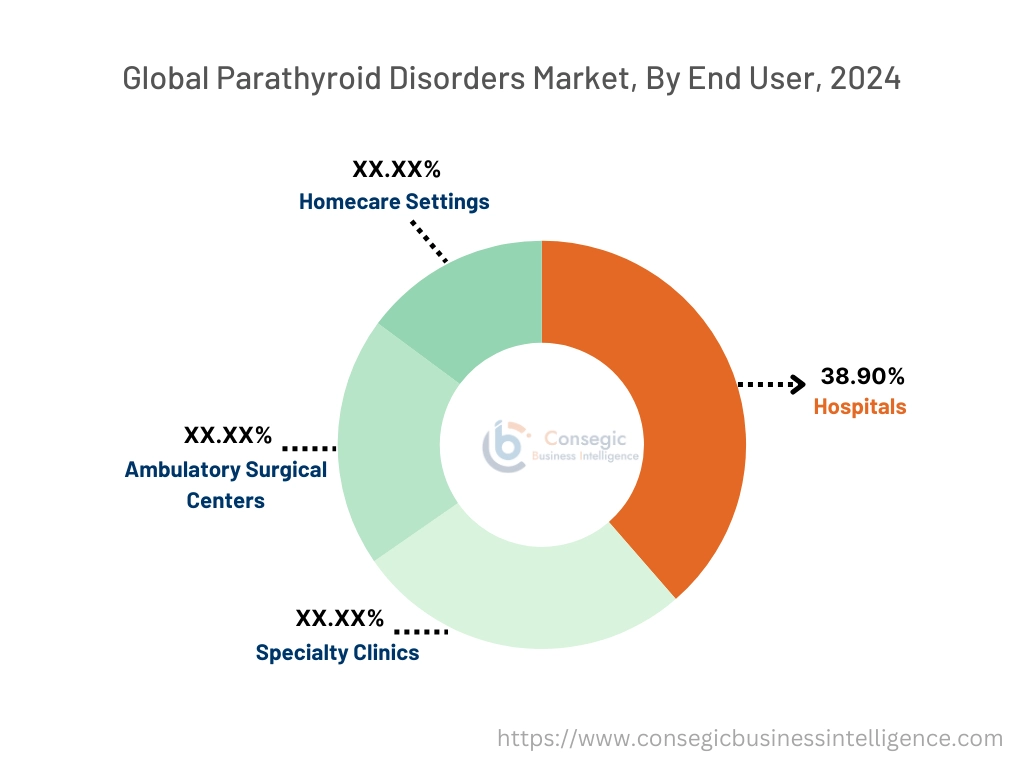
Regional Analysis:
The regions covered are North America, Europe, Asia Pacific, the Middle East and Africa, and Latin America.
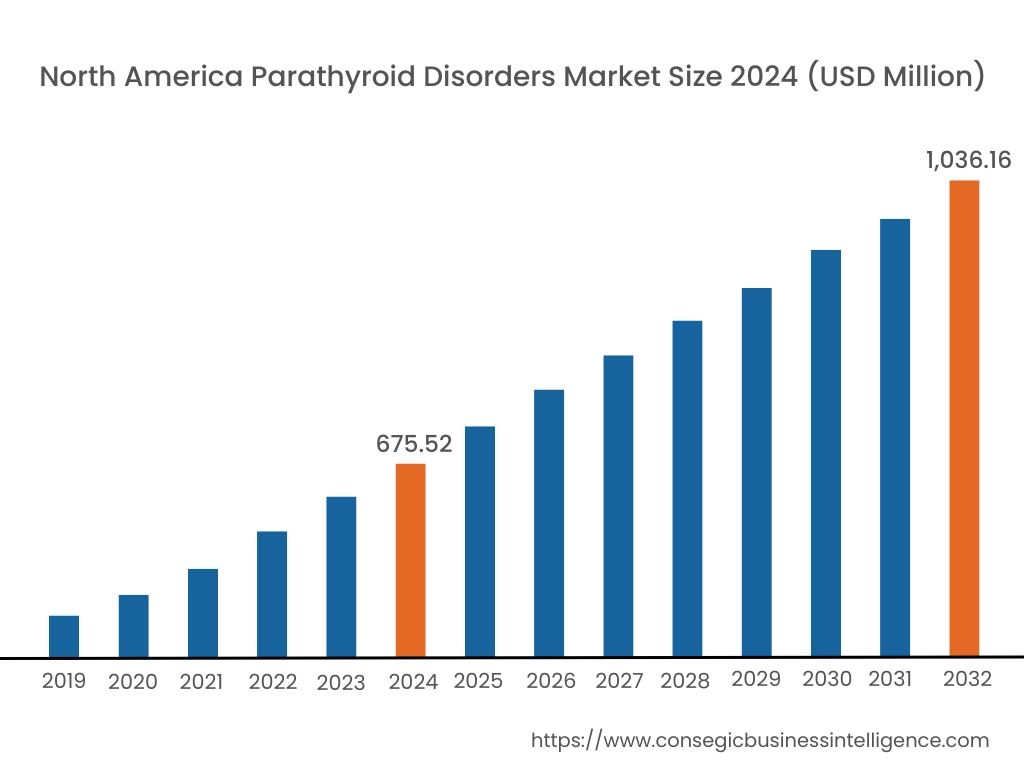
In 2024, North America was valued at USD 675.52 Million and is expected to reach USD 1,036.16 Million in 2032. In North America, the U.S. accounted for the highest share of 74.50% during the base year of 2024. North America holds a significant share of the global parathyroid disorders market, driven by a rising prevalence of adenomas, hyperplasia, and, parathyroid cancer. Other factors such as kidney disease, genetic conditions, and certain medications can also contribute to these disorders.
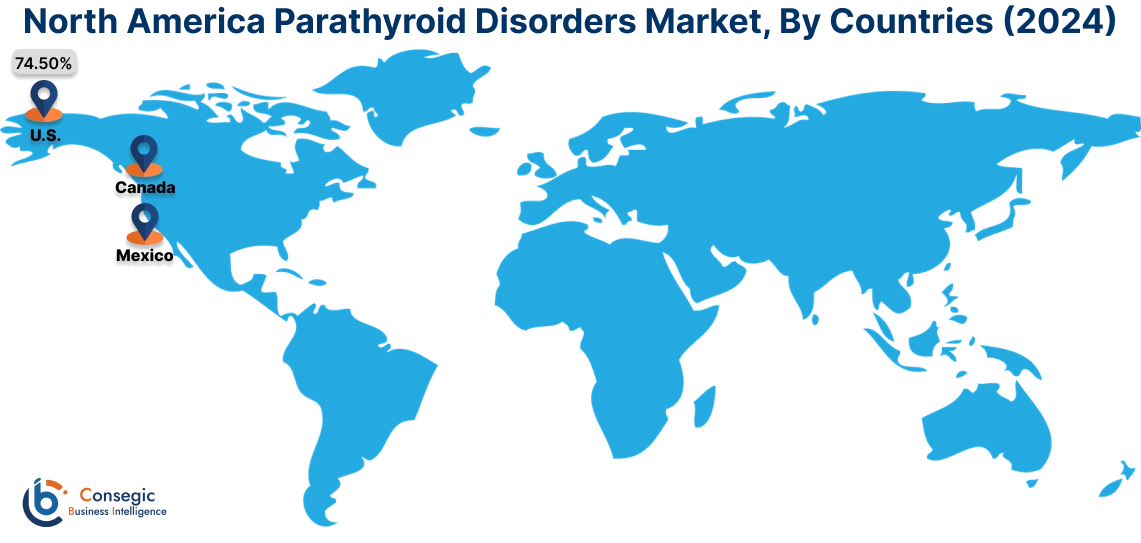
In Asia Pacific, the market is experiencing the fastest growth with a CAGR of 6.2% over the forecast period. The market analysis shows that the market is driven by the rising prevalence of disorders including genetic predispositions, dietary deficiencies, and certain medical conditions.
Europe is a prominent market, supported by advancements in diagnostic technologies. Moreover, the widespread availability of standard laboratory testing, particularly for serum calcium and PTH measurements, has shifted the diagnosis of PHPT to asymptomatic cases. The Middle East & Africa region is witnessing steady growth in the market, driven by factors such as vitamin D deficiency, pollution, and genetic predispositions. Latin America is an emerging market, due to dietary habits, vitamin D deficiency, and genetic factors, among others.
Top Key Players and Market Share Insights:
The parathyroid disorders market is highly competitive with major players providing products to the national and international markets. Key players are adopting several strategies in research and development (R&D), product innovation, and end-user launches to hold a strong position in the parathyroid disorders market. Key players in the parathyroid disorders industry include -
- Amgen Inc. (United States)
- Takeda Pharmaceutical Company Limited (Japan)
- Ascendis Pharma A/S (Denmark)
- Kyowa Kirin Co., Ltd. (Japan)
- Amryt Pharma (Ireland)
- Shire (part of Takeda Pharmaceutical Company) (Ireland)
- Roche Holding AG (Switzerland)
- Sanofi S.A. (France)
- Novartis AG (Switzerland)
- Pfizer Inc. (United States)
Recent Industry Developments :
Approvals:
- In August 2024, Ascendis Pharma received U.S. FDA approval for Yorvipath, a once-daily therapy for adult hypoparathyroidism patients. This approval positions Yorvipath as the sole approved treatment in the U.S. following the discontinuation of Takeda's Natpara at the end of 2024. Clinical studies have demonstrated that most patients treated with Yorvipath do not require daily vitamin D and calcium supplements, which are standard in current care. Ascendis plans to launch Yorvipath in early 2025, with peak sales projected to reach $2.5 billion, indicating a significant advancement in the parathyroid disorders market.
Parathyroid Disorders Market Report Insights :
| Report Attributes | Report Details |
| Study Timeline | 2019-2032 |
| Market Size in 2032 | USD 3,197.02 Million |
| CAGR (2025-2032) | 5.8% |
| By Type |
|
| By Diagnosis |
|
| By Treatment |
|
| By End-Use |
|
| By Region |
|
| Key Players |
|
| North America | U.S. Canada Mexico |
| Europe | U.K. Germany France Spain Italy Russia Benelux Rest of Europe |
| APAC | China South Korea Japan India Australia ASEAN Rest of Asia-Pacific |
| Middle East and Africa | GCC Turkey South Africa Rest of MEA |
| LATAM | Brazil Argentina Chile Rest of LATAM |
| Report Coverage |
|
Key Questions Answered in the Report
What is the projected market size of the Parathyroid Disorders Market by 2032? +
Parathyroid Disorders Market size is estimated to reach over USD 3,197.02 Million by 2032 from a value of USD 2,036.48 Million in 2024 and is projected to grow by USD 2,118.31 Million in 2025, growing at a CAGR of 5.8% from 2025 to 2032.
What are parathyroid disorders? +
Parathyroid disorders include conditions such as hyperparathyroidism, hypoparathyroidism, and parathyroid cancer, which affect the parathyroid glands and disrupt calcium balance in the body.
What are the major drivers for the Parathyroid Disorders Market? +
The rising prevalence of parathyroid disorders, advancements in diagnostic technologies, and increasing awareness about endocrine health are key drivers for the market.
What are the challenges in managing parathyroid disorders? +
Limited awareness, underdiagnosis due to non-specific symptoms, and the high cost of advanced treatments are significant challenges affecting the management of parathyroid disorders.
Which type segment dominates the market? +
The hyperparathyroidism segment dominates the market due to its high prevalence and advancements in surgical treatments, such as minimally invasive parathyroidectomy.
